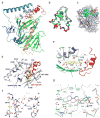Structural mechanism for sterol sensing and transport by OSBP-related proteins
- PMID: 16136145
- PMCID: PMC1431608
- DOI: 10.1038/nature03923
Structural mechanism for sterol sensing and transport by OSBP-related proteins
Abstract
The oxysterol-binding-protein (OSBP)-related proteins (ORPs) are conserved from yeast to humans, and are implicated in the regulation of sterol homeostasis and in signal transduction pathways. Here we report the structure of the full-length yeast ORP Osh4 (also known as Kes1) at 1.5-1.9 A resolution in complexes with ergosterol, cholesterol, and 7-, 20- and 25-hydroxycholesterol. We find that a single sterol molecule binds within a hydrophobic tunnel in a manner consistent with a transport function for ORPs. The entrance is blocked by a flexible amino-terminal lid and surrounded by basic residues that are critical for Osh4 function. The structure of the open state of a lid-truncated form of Osh4 was determined at 2.5 A resolution. Structural analysis and limited proteolysis show that sterol binding closes the lid and stabilizes a conformation favouring transport across aqueous barriers and signal transmission. The structure of Osh4 in the absence of ligand exposes potential phospholipid-binding sites that are positioned for membrane docking and sterol exchange. On the basis of these observations, we propose a model in which sterol and membrane binding promote reciprocal conformational changes that facilitate a sterol transfer and signalling cycle.
Figures




Comment in
-
A new way for sterols to walk on water.Mol Cell. 2005 Sep 16;19(6):722-3. doi: 10.1016/j.molcel.2005.08.006. Mol Cell. 2005. PMID: 16168368
Similar articles
-
Sterol binding and membrane lipid attachment to the Osh4 protein of yeast.J Phys Chem B. 2010 Oct 28;114(42):13562-73. doi: 10.1021/jp106890e. J Phys Chem B. 2010. PMID: 20925360
-
Oxysterol-binding proteins: sterol and phosphoinositide sensors coordinating transport, signaling and metabolism.Prog Lipid Res. 2013 Oct;52(4):529-38. doi: 10.1016/j.plipres.2013.06.004. Epub 2013 Jul 2. Prog Lipid Res. 2013. PMID: 23830809 Review.
-
The sterol-binding protein Kes1/Osh4p is a regulator of polarized exocytosis.Traffic. 2011 Nov;12(11):1521-36. doi: 10.1111/j.1600-0854.2011.01265.x. Epub 2011 Sep 12. Traffic. 2011. PMID: 21819498
-
Nonvesicular sterol movement from plasma membrane to ER requires oxysterol-binding protein-related proteins and phosphoinositides.J Cell Biol. 2006 Apr 10;173(1):107-19. doi: 10.1083/jcb.200510084. Epub 2006 Apr 3. J Cell Biol. 2006. PMID: 16585271 Free PMC article.
-
Characteristics of oxysterol binding proteins.Int Rev Cytol. 2008;265:253-85. doi: 10.1016/S0074-7696(07)65007-4. Int Rev Cytol. 2008. PMID: 18275891 Review.
Cited by
-
Structural determinants of cholesterol recognition in helical integral membrane proteins.Biophys J. 2021 May 4;120(9):1592-1604. doi: 10.1016/j.bpj.2021.02.028. Epub 2021 Feb 26. Biophys J. 2021. PMID: 33640379 Free PMC article.
-
You are lost without a map: Navigating the sea of protein structures.Biochim Biophys Acta. 2015 Apr;1854(4):258-68. doi: 10.1016/j.bbapap.2014.12.021. Epub 2014 Dec 29. Biochim Biophys Acta. 2015. PMID: 25554228 Free PMC article. Review.
-
Nonsex genes in the mating type locus of Candida albicans play roles in a/α biofilm formation, including impermeability and fluconazole resistance.PLoS Pathog. 2012 Jan;8(1):e1002476. doi: 10.1371/journal.ppat.1002476. Epub 2012 Jan 12. PLoS Pathog. 2012. PMID: 22253594 Free PMC article.
-
Nanoscale architecture of a VAP-A-OSBP tethering complex at membrane contact sites.Nat Commun. 2021 Jun 8;12(1):3459. doi: 10.1038/s41467-021-23799-1. Nat Commun. 2021. PMID: 34103503 Free PMC article.
-
ER-PM Contact Sites - SNARING Actors in Emerging Functions.Front Cell Dev Biol. 2021 Feb 11;9:635518. doi: 10.3389/fcell.2021.635518. eCollection 2021. Front Cell Dev Biol. 2021. PMID: 33681218 Free PMC article. Review.
References
-
- Dawson PA, Ridgway ND, Slaughter CA, Brown MS, Goldstein JL. cDNA Cloning and Expression of Oxysterol-Binding Protein, an Oligomer with a Potential Leucine Zipper. J Biol Chem. 1989;264:16798–16803. - PubMed
-
- Olkkonen VM, Levine TP. Oxysterol binding proteins: in more than one place at one time? Biochem Cell Biol. 2004;82:87–98. - PubMed
-
- Beh CT, Rine J. A role for yeast oxysterol-binding protein homologs in endocytosis and in the maintenance of intracellular sterol-lipid distribution. J Cell Sci. 2004;117:2983–2996. - PubMed
-
- Wang P, Weng J, Anderson RGW. OSBP is a cholesterol-regulated scaffolding protein in control of ERK1/2 activation. Science. 2005;307:1472–1476. - PubMed
Publication types
MeSH terms
Substances
Grants and funding
LinkOut - more resources
Full Text Sources
Other Literature Sources
Molecular Biology Databases
Research Materials

